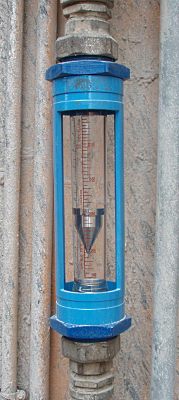property>mass flowrate
What is Mass Flowrate?

Mass flowrate is a measure of the mass that passes through a given area perpendicular to the flow in a given time. Typically this area is constrained, for example a section through a pipe, but it could also apply to an open flow.
If the velocity can be measured, and since the density and cross-sectional area are usually known, the mass flow rate is simply the product of the area, the density and the velocity. It can also be computed by taking the volumetric flowrate and multiplying it by density.
Determining mass flowrates is important in process engineering in order to control reactions and rates of heat transfer.
Measuring Mass Flow Rate
A fluid flow meter is a device used for measuring the rate of fluid flow or volumetric flow rate, from which the mass flowrate can be easily calculated using the density of the fluid as described above. In its simplest form it is comprised of a tube, and a tapered float which rises or falls depending on the flow. The float is often designed to spin with the fluid flow which reduces the chance of it getting stuck at low flow rates (or at least makes it obvious if it has done so), and because of this the device is known as a rotameter. An automatic version may have a light source and a light detecting device for remote measurement. A variety of other devices exist that work on a similar principle of a variable flow area.